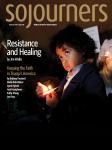ARE CLEVERLY branded fishing hats, stuffed animals, and fancy dinners to blame for the raging opioid and heroin epidemic in the U.S.?
Most of us know the breathtaking scope of that epidemic. People are dying of overdoses at a higher rate than ever in our history—nearly 80 deaths every single day. Four of every five heroin users trace their addiction back to prescription painkillers or opioids.
Less well known is the unethical corporate sales and lobbying blitz that helped trigger the epidemic. During the two decades when addiction rates climbed to unprecedented numbers, multiple pharmaceutical companies spent billions of dollars pushing physicians and patients into a downward spiral of painkiller overprescription and abuse.
Corporate painkiller promotions included dinners and junkets for physicians and direct outreach to patients. One company even funded a “pain guide” that cheerfully promoted the life-changing benefits of opioids while citing multiple “disadvantages” of over-the-counter medications such as ibuprofen. At the same time, the industry was using insider ties to rewrite the medical guidelines that justified the rash of prescriptions.
The efforts paid off. In 2010 alone, physicians wrote 254 million prescriptions for opioids, and pharmaceutical corporations raked in $11 billion in opioid sales.
Multiple companies are culpable, but the most high-profile effort was Purdue Pharma’s promotion of OxyContin. Purdue’s marketing centered on the claim, embossed on its complementary fishing hats and plush toys, that each dose of the drug provided 12 hours of relief. The lengthy duration was the factor that distinguished OxyContin from other, cheaper alternatives.
Unfortunately, for many patients, the drug’s effects did not actually last that long, according to multiple clinical trials, patient experiences, and physician reports. When OxyContin’s effects wore off before the next scheduled dose, it created desperate patients—and what one neuropharmacologist calls “the perfect recipe for addiction.” In one New York county, for example, between 1996 and 2011 opioid pill use increased 1,136 percent and heroin use rose 425 percent.
But Purdue Pharma resisted any efforts to have the drug prescribed for more frequent doses, noting in panicky internal memos that any discussion of the drug’s effect lasting less than 12 hours undermined its market niche. In 2007, Purdue Pharma executives admitted to felony fraud in their OxyContin promotions, paying fines of $634 million.
This is not just an aberrant company, and the opioid addiction is far from being the only toxic reaction to our for-profit pharmaceutical model. In areas from mental health to cancer, our current system is rife with examples of fraudulent promotions, unethical marketing to physicians, and corruption of patient advocacy groups and researchers. The industry has responded to the skyrocketing incidences of opioid overdoses with 1,500-percent increases in the cost of medicines used to respond to them. All from an industry that is routinely given monopoly patents on medicines discovered with government funding—medicines that are then sold back to taxpayers and government programs at take-it-or-leave-it pricing.
Political leaders, including President-elect Trump, have vowed to confront the industry’s excesses. In November, the pharmaceutical industry was forced to spend more than $125 million in California to fight off the first in what is likely to be a series of ballot measures to curb medicine prices.
While the chief cause of the opioid epidemic may not be branded fishing hats, it’s hard to argue with the culpability of the profit-seeking medicines system those hats represent.
It doesn’t have to be this way. For generations, medicines were treated as a public good, considered off-limits for profiteering and monopolies that block cheaper generic alternatives. Even today, government dollars still undergird the entire medicines industry, providing the opportunity to pursue multiple alternative models that control prices while still funding innovative medical research. It is time for people of faith to write a different prescription for our medicines system.

Got something to say about what you're reading? We value your feedback!

